Mardi Gras Decoration
Why Is Mardi Gras Such a Big Deal?
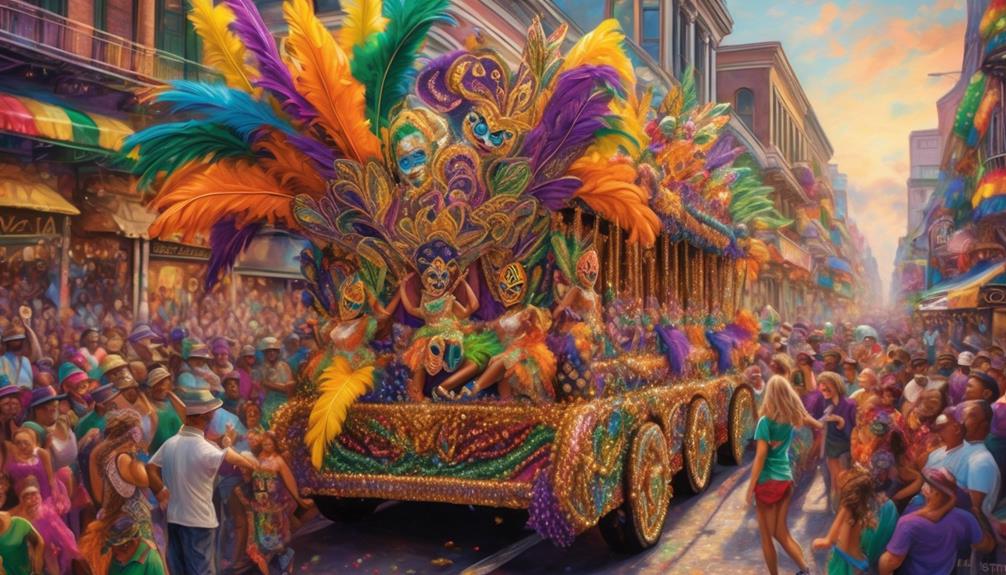
Have you ever wondered why Mardi Gras is such a big deal? We’ve all heard the adage, ‘Let the good times roll.’
The annual celebration seems to captivate the attention of people worldwide, drawing them to the colorful and lively festivities. However, behind the masks and beads lies a rich tapestry of history, culture, and tradition that makes Mardi Gras more than just a party.
As we explore the origins, religious significance, and global impact of this flamboyant event, we'll uncover the reasons why Mardi Gras continues to hold such a prominent place in the hearts of so many.
Key Takeaways
- Mardi Gras has historical roots dating back to the Middle Ages in Europe and was brought to the Americas through European colonization.
- Mardi Gras is a blend of French, Spanish, African, and Native American cultures in the United States, with each region adding its own unique flavors and traditions.
- The festival holds deep religious observance and spiritual significance, symbolizing rebirth and acting as a bridge to the solemnity of Lent.
- Mardi Gras is celebrated with diverse cultural traditions around the world, fostering community bonding, unity, and a sense of belonging among people from different backgrounds.
Origins of Mardi Gras
Mardi Gras, traditionally known as Fat Tuesday, has its origins in the medieval Christian tradition of feasting before the fasting period of Lent. This historical roots of Mardi Gras date back to the Middle Ages in Europe, where it was a time of revelry and excess before the solemnity of Lent. Over time, this tradition was brought to the Americas through European colonization and evolved into the vibrant and extravagant celebration we know today.
The cultural evolution of Mardi Gras is a fascinating study of how traditions can adapt and transform in new environments. In the United States, Mardi Gras has merged with elements of French, Spanish, African, and Native American cultures to create a unique and diverse celebration. Each region that celebrates Mardi Gras has put its own spin on the festivities, adding distinct flavors and traditions to the overall tapestry of the event.
Understanding the historical roots and cultural evolution of Mardi Gras allows us to appreciate the richness of this tradition and the ways it has been shaped by different communities. It's a reminder that traditions aren't static, but rather dynamic expressions of a community's identity and values.
Religious Significance
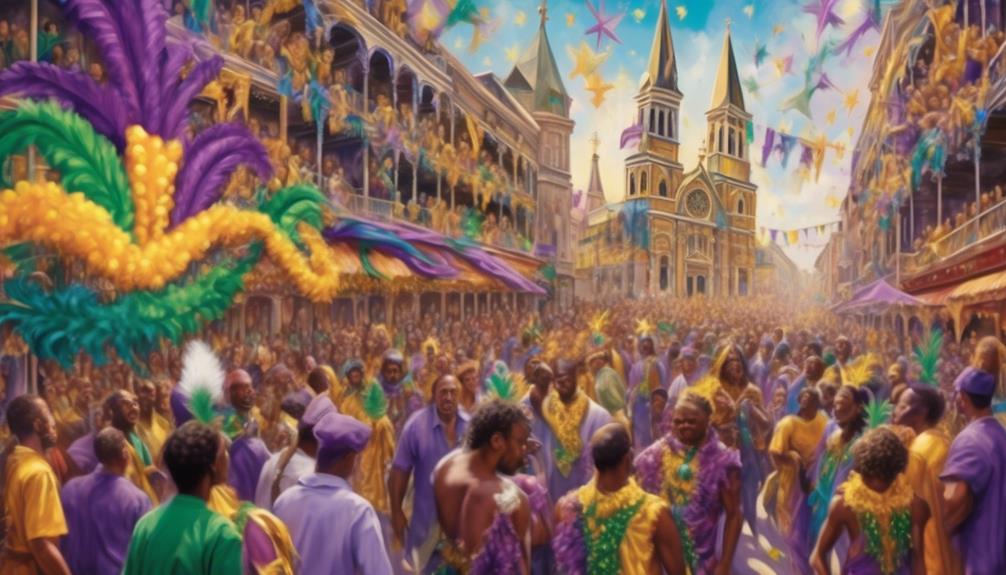
While the historical roots of Mardi Gras are firmly grounded in the traditions of feasting before the fasting period of Lent, its religious significance extends beyond the mere observance of a pre-Lenten celebration. Mardi Gras holds deep religious observance and spiritual significance for many individuals around the world. It's a time for devout observance and reflection, as well as joyous celebration.
- Celebration of Life and Community: Mardi Gras isn't only a time for indulgence but also a time for communities to come together in celebration of life and the bonds that unite them.
- Reflection and Renewal: It serves as a period for personal reflection and renewal, allowing individuals to contemplate their spiritual journey and renew their commitment to faith.
- Symbolism of Rebirth: The festivities of Mardi Gras symbolize the cycle of life, death, and rebirth, drawing parallels to the religious concept of resurrection.
- Connection to Lent: Mardi Gras acts as a bridge to the solemnity of Lent, emphasizing the importance of spiritual preparation and introspection before the start of the Lenten season.
The religious observance and spiritual significance of Mardi Gras provide a rich tapestry of traditions and beliefs, making it a profoundly meaningful event for those who partake in its observance.
Evolution of Traditions
As we explore the evolution of Mardi Gras traditions, it's fascinating to consider the historical origins and their influence on the contemporary cultural significance of the event.
Understanding how the celebration has transformed over time allows us to appreciate the rich tapestry of customs and rituals that contribute to the vibrant essence of Mardi Gras today.
Historical Origins
The historical origins of Mardi Gras can be traced back to the traditions of ancient Roman pagan celebrations and medieval European Christian feasts, which evolved over time into the festive and flamboyant event it is today. This evolution has been shaped by cultural diversity and historical significance, resulting in a vibrant tapestry of customs and practices.
- Roman Pagan Celebrations: The festival of Lupercalia, marked by feasting and revelry, influenced the early roots of Mardi Gras.
- Medieval Christian Feasts: The practice of indulging before the fasting period of Lent gave rise to the modern tradition of extravagant feasting and merrymaking.
- French Influence: The French settlers brought their own customs to Louisiana, contributing to the unique blend of traditions seen in New Orleans' Mardi Gras.
- African Influence: The incorporation of African music, dance, and cultural elements added a distinct flavor to Mardi Gras celebrations in the United States.
Contemporary Cultural Significance
Contemporary Mardi Gras celebrations showcase a dynamic blend of historical traditions and modern cultural influences, creating a vibrant and diverse tapestry of festivities. Modern interpretations of Mardi Gras have evolved to encompass a wide range of contemporary practices, reflecting the changing nature of society and the diverse communities that partake in the celebrations.
While the core elements of the festival remain rooted in history, contemporary Mardi Gras has adapted to embrace new forms of expression, including diverse musical genres, innovative parade floats, and a more inclusive approach to cultural representation. This evolution has allowed Mardi Gras to maintain its relevance in today's world, appealing to a broader audience while still honoring the rich traditions that have made it a beloved and enduring cultural phenomenon.
Global Celebrations

When it comes to Mardi Gras, the global celebrations offer a fascinating insight into the cultural significance and festive traditions associated with this lively event.
From the vibrant parades in New Orleans to the elaborate masquerade balls in Venice, Mardi Gras is celebrated in diverse ways across the world.
Exploring these global celebrations not only highlights the rich diversity of customs but also provides a comparative understanding of how different cultures embrace and celebrate this iconic festival.
Cultural Significance
Across the globe, Mardi Gras is celebrated with diverse cultural traditions, reflecting the unique customs and histories of different regions. This celebration showcases cultural diversity through a variety of practices, such as the flamboyant parades in Rio de Janeiro, the masquerade balls in Venice, the street parties in New Orleans, and the colorful processions in Sydney.
Each of these traditions highlights the distinct cultural influences and historical significance of Mardi Gras in those areas.
Moreover, Mardi Gras fosters community bonding as people come together to revel in the festivities, share meals, and partake in music and dance. This communal celebration creates a sense of belonging and unity among people from different backgrounds, emphasizing the importance of togetherness and shared experiences.
Festive Traditions
Celebrated in various corners of the world, Mardi Gras is marked by a rich tapestry of festive traditions that reflect the cultural diversity and historical significance of different regions.
The celebratory atmosphere during Mardi Gras is infectious, with vibrant parades, music, and dancing that bring communities together in joyous revelry.
One of the most captivating aspects of the festival is the traditional costumes worn by participants, each with its own unique cultural and historical roots. From the elaborate masks and flamboyant outfits of the Venetian Carnival to the feathered and beaded ensembles of New Orleans, these costumes add a sense of mystique and glamour to the festivities.
Across the globe, Mardi Gras showcases the beauty of diverse traditions, uniting people in celebration while honoring the rich heritage of their respective cultures.
Symbolism of Colors

The symbolism of colors in Mardi Gras holds significant cultural and historical significance, adding depth and meaning to the festivities. Color psychology plays a crucial role in the Mardi Gras celebrations, with each color carrying its own cultural significance.
- Purple: Symbolizing justice and royalty, purple has deep roots in Mardi Gras traditions, reflecting the values of the community and the historical ties to European royal courts.
- Green: Representing faith, green embodies the spiritual essence of the celebration, reminding participants of the religious origins of Mardi Gras.
- Gold: Signifying power and wealth, gold brings a sense of opulence and grandeur to the festivities, reflecting the desire for prosperity and success.
- Multicolored: The vibrant and diverse array of colors used in Mardi Gras costumes and decorations reflects the inclusive and celebratory nature of the event, embracing a spectrum of cultures and traditions.
The colors of Mardi Gras not only add visual splendor to the celebration but also serve as a profound representation of the values, beliefs, and history of the communities that partake in this grand festival.
Parades and Floats
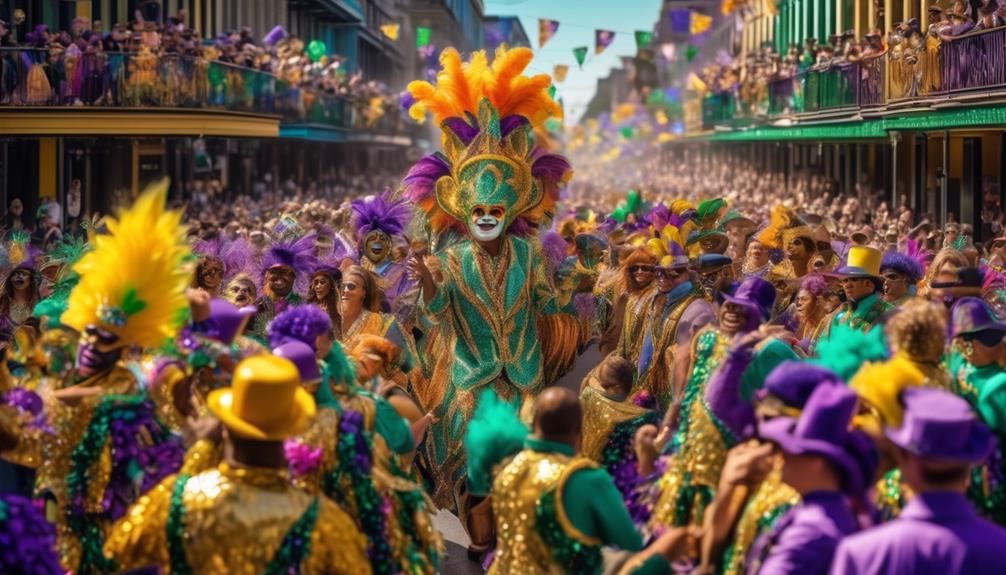
The symbolism of colors carries over seamlessly into the lively spectacles of Mardi Gras parades and floats, where the vibrancy and cultural significance of the colors come to life in a kinetic display of creativity and tradition.
Float design plays a pivotal role in these parades, with each float being a meticulously crafted embodiment of a particular theme or concept. The attention to detail in float design reflects the deep-rooted traditions and stories that form the essence of Mardi Gras.
As the floats wind their way through the streets, the crowd participation adds an extra layer of exuberance to the festivities. Spectators eagerly clamor for throws and trinkets, adding to the electric atmosphere.
The interaction between the crowd and the floats creates a unique bond, where both become integral to the overall experience.
Comparatively, Mardi Gras parades and floats aren't just about the visual spectacle but also serve as a means of storytelling and community engagement. Each float serves as a moving canvas, weaving together the tapestry of Mardi Gras traditions and contemporary creativity, inviting the crowd to immerse themselves in the vibrant narratives being presented.
This communal participation fosters a sense of unity and shared celebration, making Mardi Gras parades and floats an unforgettable experience for both participants and onlookers alike.
Masked Balls and Parties
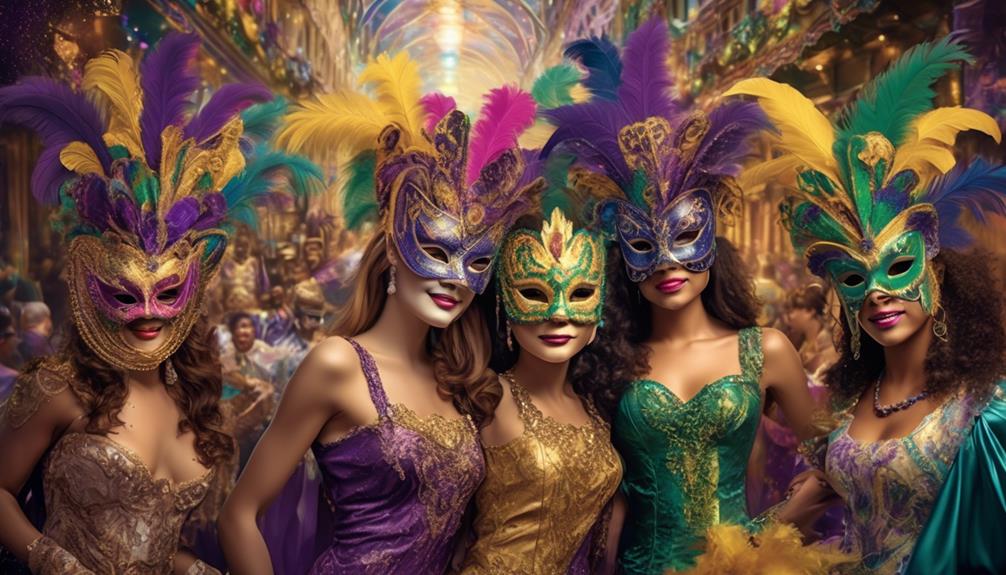
Amidst the enchanting chaos of Mardi Gras, masked balls and parties emerge as captivating expressions of revelry and tradition, weaving together the allure of secrecy and the exuberance of communal celebration.
The masked balls, with their air of mystery and allure, offer a chance for attendees to immerse themselves in a world of fantasy and disguise. The creativity of costume designs adds an element of intrigue and excitement to these events, as individuals strive to outdo each other with their elaborate disguises.
Meanwhile, the vibrant party culture during Mardi Gras fosters an atmosphere of uninhibited joy and social connection, where strangers become friends and inhibitions are set aside. The social gatherings during Mardi Gras are characterized by an overwhelming sense of inclusivity, where all are encouraged to join in the festivities regardless of background or status.
These masked balls and parties serve as a platform for individuals to indulge in the joy of shared celebration and the freedom of anonymity, making them an integral part of the rich tapestry of Mardi Gras traditions.
Culinary Delights
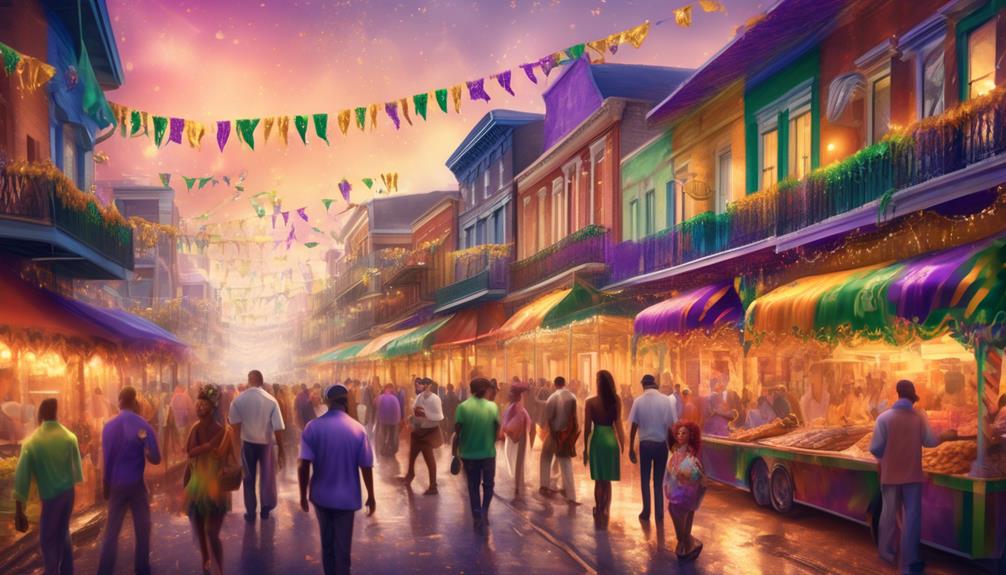
Emerging from the vibrant party culture of Mardi Gras, the culinary delights of this festive tradition captivate the senses and bring a unique flavor to the revelry. Tasty treats like beignets and king cake are synonymous with Mardi Gras, each with its own rich history and cultural significance. Beignets, a French-inspired pastry, are deep-fried to golden perfection and generously dusted with powdered sugar, making them an indulgent delight for both locals and visitors. King cake, a colorful and sweet confection, holds a tiny trinket, and whoever finds it in their slice is said to have good luck for the year.
Traditional recipes are passed down through generations, each family adding its unique twist. Gumbo, jambalaya, and étouffée are staples during this festive time, each offering a medley of flavors that pay homage to the diverse cultural influences in Louisiana. Beyond the iconic dishes, Mardi Gras also boasts an array of street food, from po'boys to crawfish boils, all meant to be enjoyed in the company of friends and family.
These delectable offerings serve as a testament to the rich culinary heritage that's deeply intertwined with the spirit of Mardi Gras.
Impact on Tourism
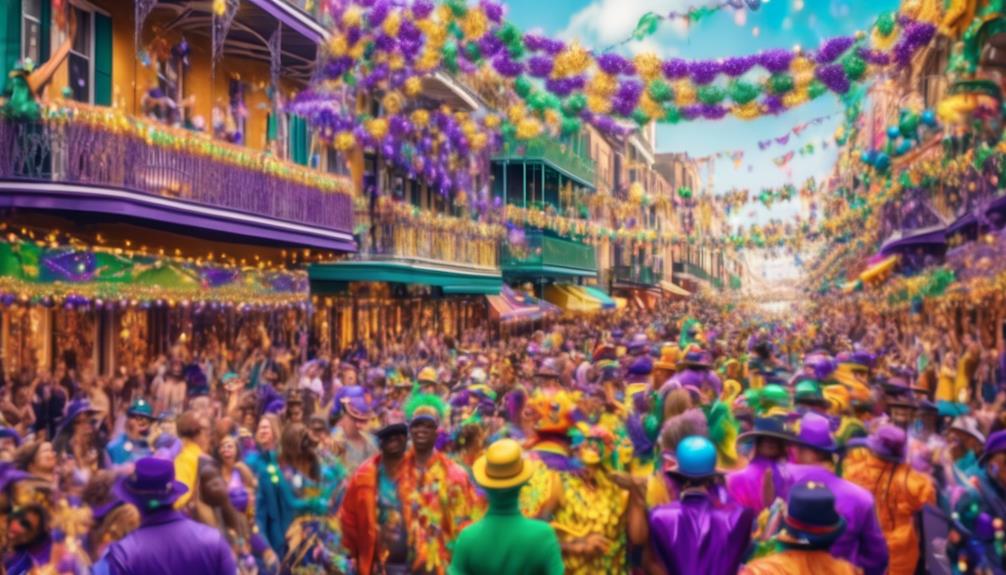
With its colorful parades and lively celebrations, Mardi Gras significantly boosts tourism in the city of New Orleans, drawing in visitors from across the globe to experience the unique festivities. The economic boost from Mardi Gras is undeniable, particularly for the hospitality industry, with hotels, restaurants, and bars experiencing a surge in business during this period.
- Hotel Occupancy: During Mardi Gras, hotel occupancy rates soar, with many establishments fully booked months in advance. This influx of visitors provides a substantial revenue stream for the hospitality sector, benefiting everyone from large hotel chains to small boutique accommodations.
- Restaurant Patronage: The city's vibrant culinary scene sees a surge in patronage during Mardi Gras, as tourists flock to savor the renowned Creole and Cajun cuisine. Local eateries experience increased foot traffic, contributing to the economic prosperity of the hospitality industry.
- Bar and Entertainment Venues: The festive atmosphere of Mardi Gras attracts revelers to the city's bars and entertainment venues, leading to heightened business activity. The hospitality sector capitalizes on the influx of tourists seeking to immerse themselves in the lively nightlife of New Orleans.
- Tourism-Related Businesses: Beyond accommodation, dining, and entertainment, various tourism-related businesses such as tour operators, souvenir shops, and transportation services also witness a surge in demand, further enhancing the economic impact of Mardi Gras on the hospitality industry.
Economic Significance
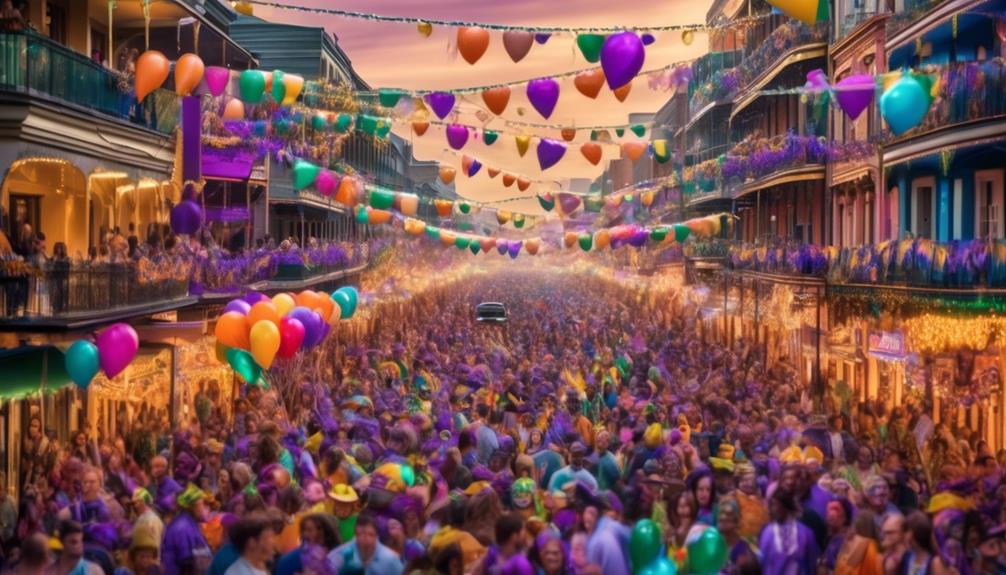
The substantial economic impact of Mardi Gras on the hospitality industry is exemplified by the surge in hotel occupancy rates, restaurant patronage, and business activity in bars and entertainment venues, all contributing to the city's economic prosperity during this festive period.
The economic impact of Mardi Gras extends far beyond the traditional sectors of hospitality and tourism. Job creation is a significant outcome of this festival. The influx of tourists not only boosts the demand for hotel staff, restaurant workers, and event coordinators but also creates opportunities in transportation, retail, and other related service industries. This surge in demand for labor not only provides temporary employment but can also lead to long-term job creation as businesses expand to accommodate the increased activity.
Additionally, the economic impact of Mardi Gras ripples through the entire supply chain, benefiting local suppliers, artisans, and small businesses. This festive event acts as an economic catalyst, injecting vitality into the local economy and fostering a sense of community pride and engagement.
The economic significance of Mardi Gras isn't just in the numbers but in the tangible impact on the livelihoods of the city's residents.
Social and Cultural Impact

The social and cultural impact of Mardi Gras extends far beyond its festive surface, intertwining rich historical traditions with diverse community expressions and celebrations. Mardi Gras isn't just a cultural celebration; it holds deep social significance and influences society in various ways.
- Societal Influence: Mardi Gras serves as a platform for social interaction, bringing together people from different backgrounds and fostering a sense of community. It promotes inclusivity and diversity, encouraging individuals to embrace their heritage and express themselves freely.
- Cultural Impact: The festival showcases a blend of cultural influences, from the French and Spanish roots to the African, Caribbean, and Native American contributions. This amalgamation of traditions enriches the cultural tapestry of the region, highlighting the importance of preserving and celebrating diverse customs.
- Community Engagement: Mardi Gras fosters a strong sense of belonging and solidarity within communities, as people come together to organize parades, balls, and other festivities. It strengthens social bonds and encourages active participation, reinforcing the interconnectedness of society.
- Historical Legacy: The historical significance of Mardi Gras is deeply embedded in the fabric of the region, reflecting its resilience and spirit. The festival's endurance through centuries underscores its enduring cultural legacy and its ability to adapt to the evolving social landscape.
Community Involvement
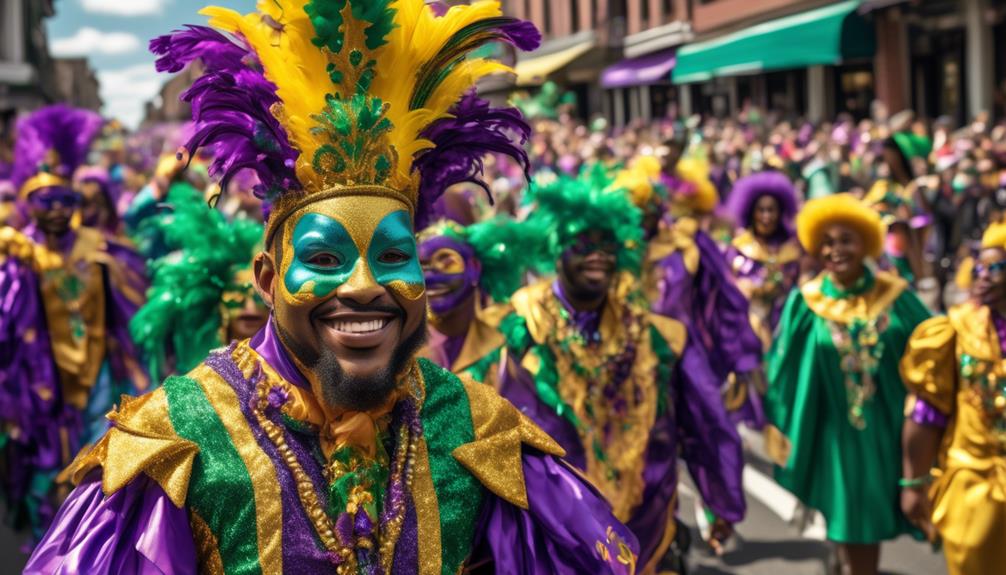
When it comes to Mardi Gras, community involvement is at the heart of the celebration. Local support and volunteer opportunities play a crucial role in bringing the festivities to life.
Comparatively, the level of community engagement sets Mardi Gras apart from other events, making it a truly inclusive and participatory experience.
Local Support
During Mardi Gras, local support and community involvement are pivotal in creating the vibrant and inclusive atmosphere that defines the celebration. Community engagement and local economy benefit from the enthusiastic participation of residents and businesses. Here's how local support contributes to the Mardi Gras experience:
- Neighborhood Parades: Local residents actively participate in organizing and participating in neighborhood parades, showcasing the unique culture and diversity of each community.
- Small Business Involvement: Local businesses, such as restaurants, bars, and shops, actively contribute to the festive atmosphere by offering special deals, themed menus, and vibrant decorations.
- Volunteer Efforts: Community members come together to volunteer for various roles, including parade marshaling, event coordination, and cleanup, ensuring the smooth running of the celebrations.
- Cultural Preservation: Through the involvement of local artists, musicians, and cultural organizations, Mardi Gras maintains its deep roots in the local heritage, adding a sense of authenticity to the festivities.
Volunteer Opportunities
As local residents, our active involvement in volunteer opportunities enhances the vibrant and inclusive atmosphere of Mardi Gras, contributing to the smooth running of the celebrations and fostering a sense of community spirit. Community engagement is at the heart of Mardi Gras, and volunteer coordination plays a pivotal role in ensuring the success of this grand event. Through event planning and outreach efforts, volunteers help organize and execute various aspects of Mardi Gras, from parade logistics to hospitality services. Our volunteer efforts not only contribute to the seamless functioning of the festivities but also deepen our connection to the community. By participating in volunteer opportunities, we actively shape the experience of Mardi Gras for both locals and visitors, making it a truly inclusive and communal celebration.
| Volunteer Roles | Responsibilities | Time Commitment | Benefits |
|---|---|---|---|
| Parade Support | Assist with crowd control, safety measures | Flexible | Front row view of parades |
| Hospitality Services | Welcome and assist visitors, distribute information | Shift-based | Networking opportunities, community engagement |
| Event Planning | Assist in organizing and coordinating event logistics | Varied | Skill development, hands-on experience |
Mardi Gras Controversies
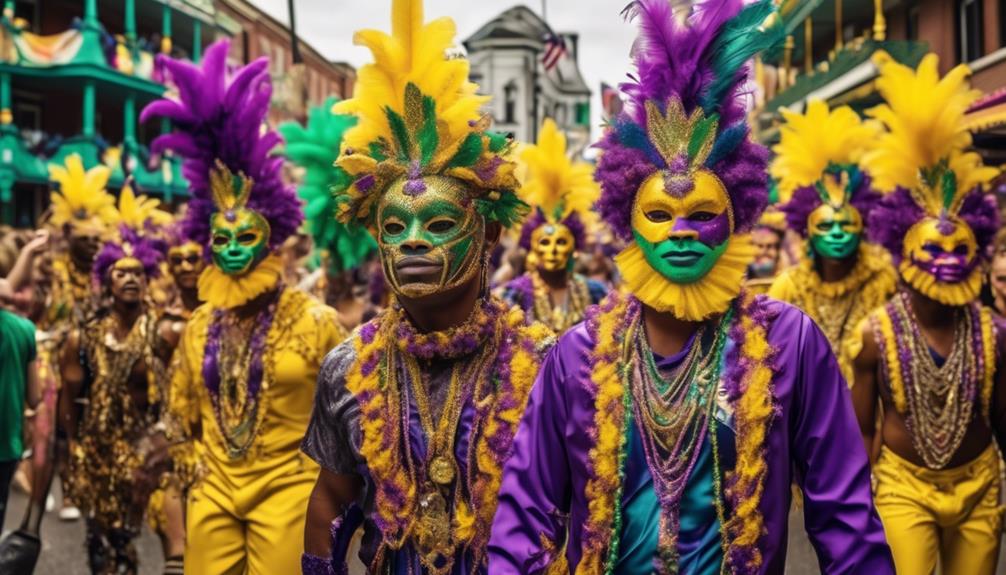
Mardi Gras controversies often stem from the clash between traditional cultural celebrations and modern societal values. As we delve into the complexities of Mardi Gras, it's important to address the controversies that have arisen in recent years.
- Controversial Celebrations: Some argue that Mardi Gras has become more about excessive partying and revelry, overshadowing its religious and cultural significance. Critics claim that the essence of the celebration has been lost in favor of commercialized festivities.
- Cultural Appropriation: The use of culturally significant symbols and traditions by non-members of the culture has sparked debates about cultural appropriation. Some argue that certain aspects of Mardi Gras, such as costumes and parades, perpetuate stereotypes and disrespect the origins of the festival.
- Inclusivity and Representation: Discussions have emerged around the lack of diverse representation in Mardi Gras festivities. Critics highlight the need for greater inclusivity and cultural sensitivity in the participation and organization of events.
- Environmental Impact: The environmental consequences of Mardi Gras, particularly the extensive use of plastic beads and waste generated during the celebrations, have raised concerns about sustainability and responsible event management.
These controversies reflect the ongoing tension between preserving tradition and adapting to modern values, prompting important conversations about the future direction of Mardi Gras.
Future of Mardi Gras

The future of Mardi Gras holds significant implications for its cultural relevance and societal impact. As we look ahead, economic impact and community engagement are pivotal considerations.
Mardi Gras isn't just a festival but a significant contributor to the economic prosperity of the regions where it's celebrated. Balancing the economic benefits with the needs of the local community will be crucial for its sustainable growth.
Moreover, addressing environmental sustainability is imperative. The festival's large-scale events can have a notable ecological footprint. Embracing eco-friendly practices and promoting environmental stewardship will be essential for Mardi Gras to align with the growing global focus on sustainability.
Additionally, technological innovations offer exciting opportunities for Mardi Gras. From enhancing the visitor experience through interactive apps to implementing digital solutions for waste management, technology can revolutionize the festival while ensuring operational efficiency.
Frequently Asked Questions
How Do Different Cultures Around the World Celebrate Mardi Gras?
Cross cultural comparisons reveal diverse celebrations of Mardi Gras worldwide. Festive rituals vary, from the vibrant parades and masquerade balls of New Orleans, to the lively street parties of Brazil's Carnival.
Each culture infuses unique traditions, such as Italy's Carnevale with its elaborate masks and costumes, or the Caribbean's Junkanoo festivities.
These celebrations showcase the rich tapestry of global traditions, uniting people in joyous revelry.
What Are Some Lesser-Known Mardi Gras Traditions and Customs?
Mardi Gras costumes play a significant role in the celebration, representing diverse cultural influences and creative expressions.
Parade traditions aren't just about the floats and beads; they showcase the community's heritage and values.
Lesser-known customs like the Courir de Mardi Gras in rural Acadiana or the Zulu coconut throws add depth to the festivities.
These unique traditions highlight the rich tapestry of Mardi Gras and make it a truly unforgettable experience.
How Has Technology and Social Media Impacted the Way Mardi Gras Is Celebrated?
Technology and social media have transformed Mardi Gras celebrations. Virtual parties and online parades have expanded the reach of the festivities, connecting people from across the globe. This shift has allowed for a more inclusive and interactive experience, but some worry it may dilute the authentic spirit of the event.
Despite these concerns, the use of technology has undeniably revolutionized the way Mardi Gras is celebrated, ushering in a new era of connection and participation.
What Environmental Impact Does Mardi Gras Have on the Communities Where It Is Celebrated?
Mardi Gras has a significant economic impact on the communities where it's celebrated. The influx of tourists boosts local businesses and creates job opportunities.
However, with large crowds come environmental concerns, such as increased waste and strain on resources.
Yet, the cultural significance of Mardi Gras can't be overlooked. It's a time-honored tradition that holds immense value for the communities, fostering a sense of identity and pride.
What Are Some Potential Future Changes or Developments for Mardi Gras Celebrations?
Potential future changes for Mardi Gras celebrations could include more virtual celebrations to reach a wider audience and adapt to changing times.
Sustainable practices may also become more prevalent, such as reducing waste and promoting environmental awareness.
These changes could enhance the overall experience, while also addressing the environmental impact of traditional celebrations.
Embracing virtual platforms and sustainable practices could ensure that Mardi Gras remains a vibrant and inclusive celebration for years to come.
Conclusion
In conclusion, Mardi Gras is a vibrant celebration with deep religious and cultural roots. Its colorful parades, lively music, and elaborate costumes create a visual spectacle that captivates the senses.
The evolution of traditions and global celebrations showcase the enduring impact of Mardi Gras on communities worldwide. Despite controversies, the future of Mardi Gras remains bright, as it continues to bring people together in joyful festivities and cultural exchange.
- About the Author
- Latest Posts
Introducing Ron, the home decor aficionado at ByRetreat, whose passion for creating beautiful and inviting spaces is at the heart of his work. With his deep knowledge of home decor and his innate sense of style, Ron brings a wealth of expertise and a keen eye for detail to the ByRetreat team.
Ron’s love for home decor goes beyond aesthetics; he understands that our surroundings play a significant role in our overall well-being and productivity. With this in mind, Ron is dedicated to transforming remote workspaces into havens of comfort, functionality, and beauty.
Mardi Gras Decoration
What Exactly Is Mardi Gras Celebrating?

As we approach Mardi Gras, it’s like looking through a kaleidoscope of traditions, colors, and celebrations.
But what exactly lies at the heart of this exuberant celebration? Mardi Gras is not just about beads, parades, and revelry; it carries a rich tapestry of history, culture, and symbolism that has woven its way through time.
From its ancient origins to its modern-day manifestations, Mardi Gras has evolved into a global phenomenon with profound significance.
So, what is it really celebrating? Stay tuned as we unravel the layers of tradition, spirituality, and cultural impact that shape this flamboyant festival.
Key Takeaways
- Mardi Gras celebrates a vibrant and culturally rich tradition with origins in ancient Roman pagan celebrations.
- It has deep religious roots in the Catholic faith and marks the beginning of Lent.
- Mardi Gras incorporates Christian beliefs through religious processions and church services.
- The festival is known for its colorful parades, floats, costumes, masks, and music, showcasing creativity, community spirit, and cultural heritage.
Origins of Mardi Gras
The origins of Mardi Gras can be traced back to ancient Roman pagan celebrations, particularly the festival of Lupercalia. This ancient festival, held in mid-February, was a time of feasting and revelry to honor the coming of spring and fertility. The traditions of Lupercalia included masquerade, parades, and the donning of masks and costumes, elements that are still prominent in modern Mardi Gras celebrations. The festival also featured pagan rituals aimed at purifying the city and promoting health and fertility.
These ancient roots reveal the deep historical and cultural significance of Mardi Gras. The transition from Lupercalia to Mardi Gras reflects the evolution of traditions and the blending of different cultural practices over time. The essence of Mardi Gras as a time of indulgence and merrymaking has endured through the ages, maintaining its ties to the ancient pagan rituals while also evolving to encompass a diverse array of customs and celebrations.
Understanding the connections between Mardi Gras and its ancient origins provides a profound insight into the enduring significance of this vibrant and colorful celebration in our modern world.
Historical Significance

With roots tracing back to ancient Roman pagan celebrations, Mardi Gras holds a profound historical significance as a vibrant and culturally rich tradition. This celebration has evolved over centuries, blending diverse cultural roots and festive rituals that enhance its allure and significance. Here's a closer look at the historical context and societal significance that has shaped Mardi Gras into the beloved event it's today:
- Cultural Roots: Mardi Gras draws from a tapestry of cultural influences, including French, Spanish, African, and Native American traditions. This amalgamation has fostered a unique and inclusive celebration that resonates with people from all walks of life.
- Festive Rituals: The colorful parades, elaborate costumes, and lively music are integral to Mardi Gras, reflecting the joyous and communal spirit of the event. These festive rituals not only entertain but also serve as a means of cultural expression and solidarity.
- Historical Context: From its origins as a pre-Lenten revelry to its modern-day manifestations, Mardi Gras has weathered historical changes, adapting to societal norms and challenges while retaining its essential spirit of revelry and resilience.
- Societal Significance: Mardi Gras has become a symbol of unity and resilience, providing a platform for communities to come together, celebrate diversity, and showcase their cultural heritage. Its societal significance extends beyond mere revelry, embodying the resilience and vibrancy of the human spirit.
Christian Connection
Incorporating Christian traditions and beliefs, the Mardi Gras celebration reflects a fascinating interplay of religious observance and cultural revelry, enriching its historical tapestry and cultural significance. Mardi Gras, also known as Fat Tuesday, has deep religious roots, primarily in the Catholic faith. This celebration is a time of feasting and merriment before the solemn season of Lent, emphasizing the contrast between indulgence and abstinence. The table below illustrates the intertwining of religious significance and cultural roots in the Mardi Gras celebration.
| Religious Significance | Cultural Roots |
|---|---|
| Marks the beginning of Lent, a period of penance and fasting | Traces back to ancient pagan festivals celebrating the arrival of spring |
| Represents the last opportunity for merrymaking before the 40 days of Lent | Evolved into a grand celebration with vibrant parades, music, and elaborate costumes |
| Incorporates Christian beliefs in the form of religious processions and church services | Showcases a blend of European, African, and American cultural influences |
The Christian connection in Mardi Gras serves as a reminder of the festival's rich historical and cultural significance, where religious traditions intersect with communal revelry, creating a unique and enduring celebration.
Symbolism and Traditions

The colors of Mardi Gras, purple, green, and gold, hold deep symbolic meaning, with purple representing justice, green for faith, and gold for power.
The elaborate costumes worn during the celebrations are a visual representation of the opulence and extravagance associated with the festival.
Parades and floats are a cornerstone of Mardi Gras traditions, showcasing vibrant displays of creativity and community spirit.
Colors and Costumes
How do the vibrant colors and elaborate costumes of Mardi Gras reflect the rich symbolism and traditions of this festive celebration?
- Color Symbolism: The traditional colors of Mardi Gras – purple, green, and gold – hold deep symbolic meanings. Purple signifies justice, green represents faith, and gold symbolizes power. These colors aren't only aesthetically pleasing but also carry a profound significance that resonates with the spirit of the celebration.
- Festive Attire: The elaborate and flamboyant costumes worn during Mardi Gras are a testament to the festive spirit and the celebration of individuality. The colorful and extravagant outfits are a reflection of the joy and exuberance that characterizes this lively event.
- Costume Traditions: The intricate and ornate costumes worn during Mardi Gras have been passed down through generations, representing a rich tapestry of cultural traditions and customs.
- Cultural Significance: The costumes and colors of Mardi Gras serve as a vibrant expression of cultural heritage, uniting communities and celebrating the diversity of traditions.
Parades and Floats
The vibrant colors and elaborate costumes of Mardi Gras, reflective of its rich symbolism and traditions, give way to the grand spectacle of parades and floats, embodying deeper cultural meanings and historical significance.
Spectacular displays of creativity and artistry unfold through these colorful processions, where each float represents a unique story or theme. The floats, with their elaborate constructions, are a manifestation of the community's collective creativity and craftsmanship. Each float is meticulously designed, often with hidden symbolism and historical references, adding layers of meaning to the parade.
These parades aren't merely a display of opulence; they're a living reflection of the city's history, culture, and values. The floats and parades become a platform for communities to express their collective pride and celebrate their heritage, fostering a sense of togetherness and belonging.
Masks and Beads
Throughout history, masks and beads have played a pivotal role in the cultural and symbolic tapestry of Mardi Gras, embodying traditions that have been passed down through generations. These traditional accessories are more than just festive attire; they hold deep cultural significance and symbolism for the celebration.
- Masks: These have been a central aspect of Mardi Gras, allowing wearers to momentarily escape societal constraints and embrace anonymity, symbolizing the freedom of expression and the shedding of inhibitions.
- Beads: Serving as colorful tokens of celebration, these beads are thrown and caught during parades, symbolizing unity and the spirit of giving within the community.
- Historical Significance: Masks and beads have been used in Mardi Gras celebrations since the early 1700s, representing the fusion of diverse cultural influences from French, African, and Native American traditions.
- Cultural Tradition: The donning of masks and the exchange of beads have become enduring symbols of the festive spirit and camaraderie that define Mardi Gras.
Evolution of Celebrations
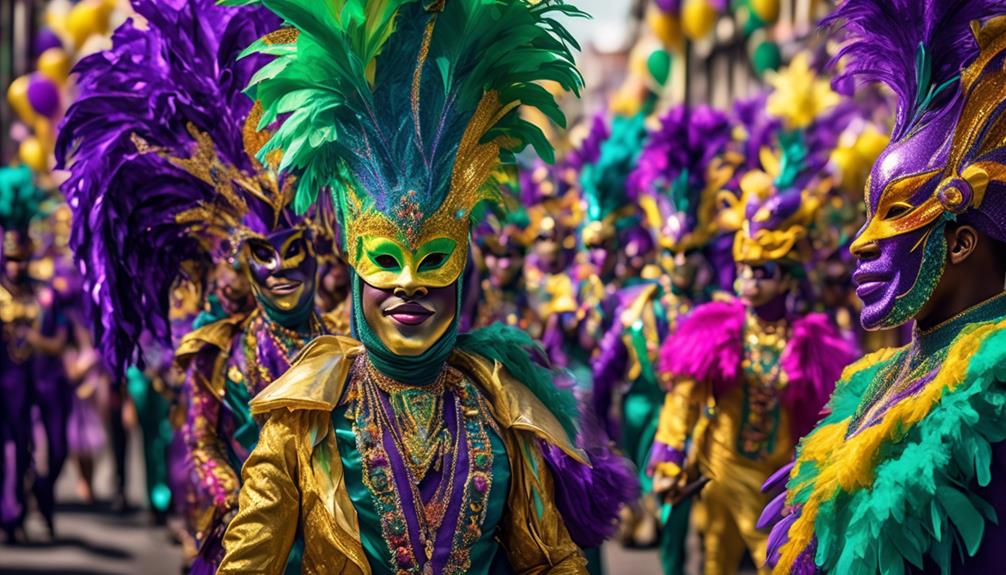
As we explore the evolution of Mardi Gras celebrations, it's crucial to understand the origins of the traditions and the cultural influences that have shaped this festive occasion.
By delving into the historical context, we can gain insight into how Mardi Gras has evolved over time, adapting to various influences and societal changes.
From the early beginnings to the modern-day festivities, the evolution of Mardi Gras celebrations offers a fascinating glimpse into the cultural significance and enduring traditions that continue to captivate and unite communities.
Origins of Traditions
Through the centuries, Mardi Gras celebrations have evolved, incorporating a rich tapestry of traditions that reflect the cultural heritage of the communities that have embraced this festive occasion. The origins of these traditions can be traced back to ancient roots, and they hold significant cultural significance even today.
- Masked Balls: These elaborate events have origins in medieval Europe, where social norms were temporarily inverted, allowing people to partake in festivities without judgement.
- Parades and Floats: The practice of parading with colorful floats and costumes can be linked to pagan spring festivals, symbolizing the renewal of life and the casting away of winter.
- Throwing of Beads and Trinkets: This tradition has its roots in the practice of tossing food and other items to the crowd during ancient Roman celebrations.
- King Cake: The tradition of baking and sharing King Cake can be traced back to the Middle Ages, symbolizing the search for the baby Jesus and the arrival of the Three Kings.
These enduring traditions have woven together a vibrant tapestry of cultural significance, making Mardi Gras a celebration that encapsulates the spirit of unity and revelry.
Cultural Influences
Influenced by a myriad of cultural traditions and historical legacies, the evolution of Mardi Gras celebrations has shaped a vibrant tapestry of festivities that hold profound significance within the communities that partake in the revelry.
The influences on Mardi Gras are as diverse as the revelers themselves, stemming from the French Catholic traditions of the first settlers in Louisiana, to the African, Spanish, and Native American cultural influences that have molded the celebration over the centuries.
These cultural influences have led to a unique societal impact, fostering a sense of unity and inclusivity within the communities that embrace the Mardi Gras traditions.
The celebration serves as a platform for cultural expression and a reflection of the rich tapestry of influences that have shaped the region, ultimately contributing to the vibrant and diverse cultural landscape of Mardi Gras.
Modern-Day Festivities
The evolution of Mardi Gras celebrations in modern times has witnessed a dynamic transformation, reflecting the ever-changing cultural, social, and historical influences that continue to shape this iconic festivity. In contemporary society, Mardi Gras has evolved into a multifaceted celebration, embracing diverse elements that resonate with the community spirit and social gatherings.
- Inclusive Parades: Modern Mardi Gras parades now encompass a wide array of cultural representations, showcasing the inclusivity and diversity of the community.
- Interactive Events: Festivities now include interactive events, such as community balls and masquerade parties, fostering a sense of camaraderie amongst participants.
- Culinary Experiences: The modern Mardi Gras celebration highlights regional culinary experiences, emphasizing the significance of food in fostering communal bonds.
- Charitable Initiatives: Many modern Mardi Gras events incorporate charitable initiatives, amplifying the community-oriented nature of the celebration.
Global Cultural Impact

Mardi Gras has left an indelible mark on cultures around the world, its vibrant celebrations and traditions resonating across continents and through the annals of history. The cross-cultural influences of Mardi Gras are evident in various modern interpretations of the festival, showcasing the ways in which it has transcended its origins to become a global phenomenon.
| Cultural Impact | Historical Context | Significance |
|---|---|---|
| Carnival in Brazil | The tradition of Carnival in Brazil has roots in the Portuguese entrudo, which combines elements of European, African, and indigenous cultures. | Carnival in Brazil is a vibrant example of how Mardi Gras has influenced and integrated with diverse cultural practices, becoming an essential part of Brazil's cultural identity. |
| New Orleans Jazz | The evolution of jazz in New Orleans was deeply influenced by the multicultural and multiracial environment of the city, with Mardi Gras providing a platform for the expression of this musical genre. | The global recognition of New Orleans jazz as a result of Mardi Gras has contributed to the preservation and celebration of African-American cultural heritage. |
| Venice Carnival | The Venice Carnival, dating back to the 12th century, has been shaped by influences from the Mediterranean, Europe, and the East, with Mardi Gras playing a significant role in its development. | The Venice Carnival's incorporation of Mardi Gras traditions highlights the enduring impact of this festival on the cultural tapestry of Europe and beyond. |
Mardi Gras has evolved into a symbol of unity and expression, transcending borders and connecting people from diverse backgrounds through its rich and multifaceted cultural impact.
Frequently Asked Questions
What Are Some Common Mardi Gras Foods and Drinks?
Traditional cuisine and festive beverages are key to Mardi Gras celebrations. From spicy jambalaya to savory gumbo, traditional Cajun and Creole dishes take center stage.
And let's not forget the king cake, a sweet treat filled with history and tradition!
Wash it all down with a refreshing Hurricane cocktail, a staple of the festivities.
Mardi Gras is all about indulging in delicious food and drinks while reveling in the spirit of celebration.
How Do Different Cultures Around the World Celebrate Mardi Gras?
Different cultures around the world celebrate Mardi Gras with diverse Carnival traditions and global festivities.
It's fascinating to note that in Brazil alone, over 2 million people per day participate in Rio de Janeiro's Carnival celebrations. The event showcases samba schools, vibrant parades, and lively music, reflecting the rich cultural tapestry of the country.
From New Orleans to Venice, Mardi Gras is a time for revelry, community, and colorful customs.
Are There Any Specific Colors or Symbols Associated With Mardi Gras?
Color symbolism plays a significant role in Mardi Gras celebrations. The traditional colors of purple, green, and gold have deep meanings.
Purple represents justice, green symbolizes faith, and gold signifies power. These colors can be seen in the vibrant costumes worn during the festivities.
The elaborate and ornate traditional costumes are a reflection of the rich cultural history and heritage associated with Mardi Gras.
What Are Some Modern-Day Interpretations of Mardi Gras Celebrations?
Modern traditions of Mardi Gras celebrations have evolved to embrace a kaleidoscope of cultural influences, infusing the revelry with vibrant music, eclectic costumes, and diverse culinary delights. This spirited festival embodies the essence of joyful abandon, uniting people in a collective celebration of life.
Through its modern interpretations, Mardi Gras has become an exuberant tapestry of traditions, reflecting the rich tapestry of cultures that contribute to its enduring legacy.
How Has Technology Influenced the Way Mardi Gras Is Celebrated?
Virtual celebrations and digital parades have revolutionized the Mardi Gras experience. With technology, we've seen a shift towards inclusive and accessible celebrations, allowing people worldwide to participate in the festivities.
Digital platforms have also provided a means for preserving and sharing the rich cultural heritage of Mardi Gras, ensuring its traditions continue to thrive. This technological influence has brought a new dimension to the celebration, bridging geographical gaps and uniting people in the spirit of Mardi Gras.
Conclusion
As we peel back the layers of history and tradition, we uncover the vibrant tapestry of Mardi Gras. Like a kaleidoscope of cultures and customs, this celebration is a melting pot of symbolism and significance.
From its Christian roots to its global impact, Mardi Gras is a testament to the power of tradition and the beauty of diversity.
It continues to be a colorful and lively tribute to the resilience of the human spirit.
- About the Author
- Latest Posts
Introducing Ron, the home decor aficionado at ByRetreat, whose passion for creating beautiful and inviting spaces is at the heart of his work. With his deep knowledge of home decor and his innate sense of style, Ron brings a wealth of expertise and a keen eye for detail to the ByRetreat team.
Ron’s love for home decor goes beyond aesthetics; he understands that our surroundings play a significant role in our overall well-being and productivity. With this in mind, Ron is dedicated to transforming remote workspaces into havens of comfort, functionality, and beauty.
Mardi Gras Decoration
Do People Drink During Mardi Gras?

Do you ever ponder the significance of alcohol in the celebrations of Mardi Gras? This inquiry frequently ignites discussions and brings up fascinating insights about cultural customs and societal conduct.
From the streets of New Orleans to the celebrations around the world, the association between Mardi Gras and drinking has always been a subject of interest. But is it just a stereotype or a deeply embedded aspect of the festival's identity?
Let's explore the complex relationship between Mardi Gras and alcohol, uncovering the historical, cultural, and social dimensions that shape this intriguing phenomenon.
Key Takeaways
- Drinking during Mardi Gras has a long historical and cultural significance, dating back to early celebrations in Europe and being brought to the New World by French settlers.
- Traditional beverages, such as the Hurricane Cocktail, Sazerac, and Mint Julep, play a significant role in reflecting the heritage and celebratory spirit of Mardi Gras.
- Alcohol consumption during Mardi Gras fosters a sense of camaraderie and shared experience among participants, enhancing the overall celebratory atmosphere and social dynamics.
- While drinking is an integral part of Mardi Gras, promoting responsible drinking through initiatives such as designated driver programs, non-alcoholic beverage options, and education campaigns is crucial to preventing alcohol-related incidents and ensuring a safe and inclusive celebration.
Historical Roots of Mardi Gras Drinking
The tradition of drinking during Mardi Gras can be traced back to the early celebrations in Europe, where the consumption of alcohol was intertwined with the revelry and communal feasting that marked the festival. Mardi Gras, also known as Fat Tuesday, has its origins in the pre-Christian period when people would engage in excessive eating and drinking before the Lenten period of fasting and abstinence. This tradition of indulgence was carried over to the New World by French settlers, particularly in the city of New Orleans, where it evolved into the extravagant and colorful festival that we know today.
The cultural significance of drinking during Mardi Gras lies in its role as a symbol of letting loose and enjoying life before the solemnity of Lent. It's a time for people to come together, celebrate, and partake in the communal spirit of the festival. The act of drinking during Mardi Gras isn't just about imbibing alcohol but is deeply rooted in the social and cultural fabric of the festival, fostering a sense of camaraderie and shared experience among participants.
As we serve others during this festive period, it's important to understand the historical roots and cultural significance of Mardi Gras drinking, acknowledging its role in bringing people together in celebration.
Traditional Beverages of Mardi Gras
Tracing the historical roots of Mardi Gras drinking leads us to the exploration of the traditional beverages that have become synonymous with this vibrant festival. As we delve into the cultural significance of Mardi Gras cocktails, it's evident that these drinks play a crucial role in the festivities, reflecting the rich heritage and celebratory spirit of the occasion.
- Hurricane Cocktail: This iconic drink, featuring rum, fruit juices, and grenadine, is a staple during Mardi Gras. Its vivid red color and sweet yet potent flavor perfectly embody the energy and liveliness of the festival.
- Sazerac: Originating from New Orleans, the Sazerac is a timeless classic that holds a special place in Mardi Gras celebrations. With its blend of rye whiskey, absinthe, and bitters, this cocktail exudes a sense of tradition and sophistication, appealing to both locals and visitors.
- Mint Julep: While traditionally associated with the Kentucky Derby, the refreshing blend of mint, sugar, and bourbon has also found its way into Mardi Gras festivities. Its cooling effect and delightful taste offer a delightful contrast to the exuberant atmosphere of the festival.
These traditional Mardi Gras beverages not only quench the thirst of revelers but also serve as cultural symbols, adding depth and flavor to this jubilant occasion.
Impact of Alcohol on Mardi Gras Culture
Exploring the impact of alcohol on Mardi Gras culture reveals its integral role in shaping the festive atmosphere and social dynamics during this lively celebration. Alcohol consumption is deeply intertwined with the cultural significance of Mardi Gras, as it plays a central role in fostering a sense of camaraderie and uninhibited revelry. The consumption of traditional beverages, such as the iconic Hurricane cocktail, contributes to the vibrant and spirited ambiance that characterizes Mardi Gras festivities. It is important to recognize the responsible service of alcohol during these celebrations, as it enhances the overall experience for participants while ensuring their safety.
| Cultural Impact | Social Dynamics | Festive Atmosphere |
|---|---|---|
| Facilitates bonding among participants | Encourages interactive and lively interactions | Creates an exuberant and celebratory vibe |
| Showcases traditional beverage heritage | Strengthens community ties | Fosters a sense of collective joy and merriment |
| Reflects the spirit of revelry and indulgence | Promotes inclusivity and conviviality | Enhances the overall celebratory experience |
Drinking Etiquette During Mardi Gras

As we immerse ourselves in the vibrant festivities of Mardi Gras, it becomes evident that understanding the drinking etiquette plays a crucial role in ensuring a harmonious and enjoyable experience for all participants.
When it comes to drinking customs during Mardi Gras, there are several key points to keep in mind:
- Pace Yourself: The party atmosphere of Mardi Gras can be exhilarating, but it's important to pace oneself when consuming alcoholic beverages. Sipping drinks slowly allows for a more enjoyable and sustainable celebration.
- Respect Others: In the midst of the revelry, it's essential to be mindful of others' boundaries and comfort levels. Always be respectful of fellow partygoers and their choices regarding alcohol consumption.
- Stay Hydrated: With the excitement of the festivities, it's easy to forget the importance of staying hydrated. Alongside alcoholic beverages, it's crucial to drink plenty of water to maintain well-being throughout the celebrations.
Understanding and adhering to these drinking customs not only enhances the overall experience of Mardi Gras but also contributes to a more inclusive and considerate celebration for everyone involved.
Alcohol-Related Incidents at Mardi Gras
Amidst the vibrant celebrations of Mardi Gras, it's crucial to acknowledge the significant impact of alcohol-related incidents on the overall experience and safety of participants. The high levels of alcohol consumption during Mardi Gras often contribute to a range of incidents, from minor disturbances to more serious accidents. It's essential for us to be aware of the potential risks associated with excessive drinking and to take proactive measures to ensure the well-being of all attendees.
One of the most effective ways to mitigate alcohol-related incidents is to promote responsible drinking. This can be achieved through the provision of non-alcoholic beverage options, promoting designated driver programs, and encouraging individuals to pace their alcohol consumption. Additionally, ensuring the availability of water stations throughout the event can help prevent dehydration and lessen the effects of alcohol.
Furthermore, implementing heightened security measures and increasing the presence of medical personnel can play a crucial role in swiftly addressing any alcohol-related incidents that may arise. By creating a safe and supportive environment, we can help safeguard the well-being of everyone participating in the Mardi Gras festivities.
Responsible Drinking Initiatives
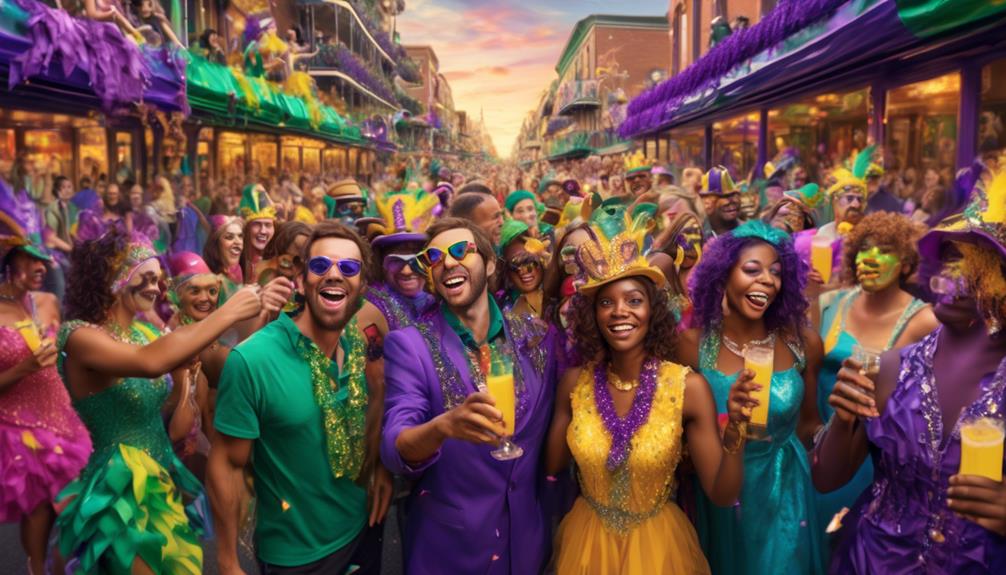
We observe the implementation of responsible drinking initiatives as a proactive approach to promoting safety and well-being during Mardi Gras celebrations. These initiatives are crucial for fostering community engagement and safeguarding public health.
Here are some key points to consider:
- Education and Awareness: Mardi Gras organizers collaborate with local public health agencies to provide educational materials and awareness campaigns about responsible alcohol consumption. These efforts aim to inform attendees about the potential risks of excessive drinking and encourage moderation.
- Designated Driver Programs: Event organizers work with transportation services to offer designated driver programs, providing incentives for individuals to volunteer as sober drivers. This proactive approach helps to ensure that attendees have a safe means of transportation, reducing the likelihood of alcohol-related incidents.
- Collaboration with Local Authorities: Responsible drinking initiatives involve close collaboration with law enforcement to enforce alcohol regulations and address any potential issues promptly. This partnership reinforces the commitment to public safety and well-being.
The Future of Drinking at Mardi Gras
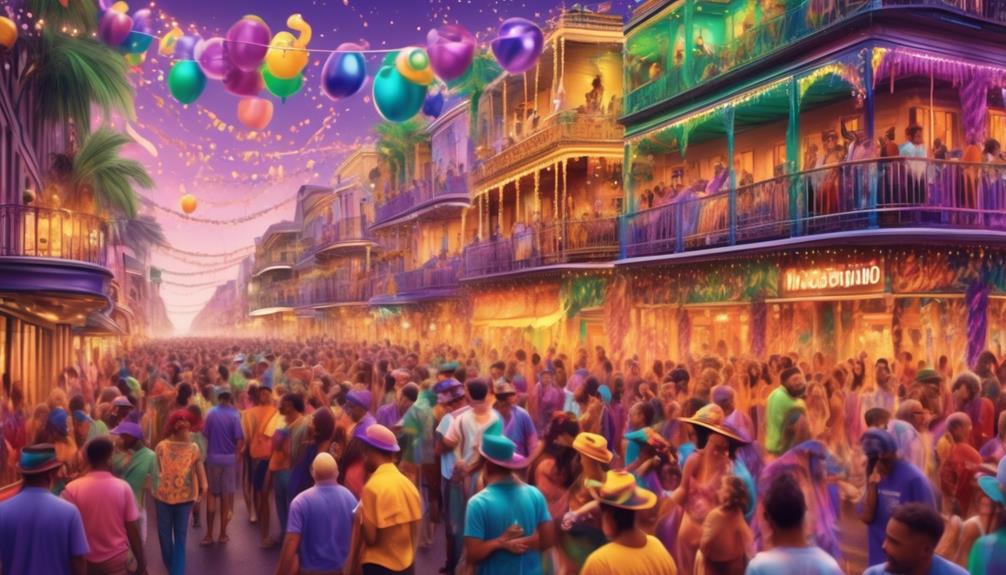
Looking ahead, the evolving landscape of drinking practices during Mardi Gras calls for a reevaluation of existing strategies and the development of innovative approaches to ensure the safety and well-being of all participants.
As we consider the future of drinking at Mardi Gras, it's essential to recognize the importance of implementing future regulations that prioritize responsible alcohol consumption. This may involve working closely with local authorities to establish guidelines for the sale and consumption of alcohol during the festivities, as well as enforcing strict penalties for those who violate these regulations.
Additionally, community involvement is crucial for fostering a culture of responsible drinking. Engaging local organizations, businesses, and residents in promoting safe drinking practices can help create a supportive environment for Mardi Gras attendees.
Looking forward, we must also explore the potential for technological advancements to aid in monitoring alcohol consumption and identifying individuals who may need assistance. Embracing innovations such as breathalyzer kiosks or mobile apps that provide information on local transportation options can contribute to a safer and more enjoyable Mardi Gras experience for everyone.
Frequently Asked Questions
How Does Mardi Gras Drinking Compare to Other Cultural Celebrations or Festivals?
When comparing cultural celebrations, drinking traditions vary widely. Mardi Gras stands out for its festive atmosphere and lively drinking culture, often involving colorful cocktails and traditional beverages.
In contrast, other cultural festivals may emphasize different aspects of celebration, with some placing less emphasis on alcohol consumption.
Understanding the unique drinking customs of each festival offers a fascinating glimpse into the diversity of global traditions and the ways in which different cultures express joy and revelry.
Are There Any Specific Health or Safety Precautions Recommended for Those Participating in Mardi Gras Drinking Activities?
Health precautions and safety tips are crucial during Mardi Gras. It's essential to stay hydrated, pace ourselves, and be mindful of alcohol consumption.
Additionally, having a designated driver or using public transportation can prevent accidents. Ensuring access to water and taking breaks can help avoid overindulgence.
It's important to be aware of our surroundings and look out for one another, especially in crowded areas.
Let's prioritize everyone's well-being while enjoying the festivities.
What Are Some Common Misconceptions or Stereotypes About Mardi Gras Drinking and How Do They Impact the Event?
Misconceptions and stereotypes about Mardi Gras drinking can impact the event's cultural impact and social behavior. People often assume that Mardi Gras is all about excessive drinking, but it's more about celebrating community and tradition. This misconception can lead to a focus on negative behaviors rather than the rich cultural history and vibrant social atmosphere of the event.
Understanding the true essence of Mardi Gras can help shift these stereotypes and promote a more positive experience for everyone.
How Do Local Businesses and Vendors Prepare for the Increased Demand for Alcohol During Mardi Gras?
Local promotions and supply chain management are crucial for businesses and vendors to meet the increased demand for alcohol during Mardi Gras.
We see local businesses collaborating with suppliers to ensure ample stock and offering special promotions to attract customers.
It's fascinating to witness how they strategize to balance supply and demand.
These efforts not only cater to the festive spirit but also showcase the meticulous planning behind the scenes.
Are There Any Legal Regulations or Restrictions on Alcohol Consumption During Mardi Gras in Different Regions?
Legal regulations on alcohol consumption during Mardi Gras vary by region. In some areas, there are specific restrictions on where and when alcohol can be consumed, while others have more relaxed policies.
For example, in New Orleans, public drinking is allowed during Mardi Gras within designated areas. Understanding the different regulations and restrictions can help attendees navigate the festivities responsibly and ensure a safe and enjoyable experience for all.
Conclusion
In conclusion, Mardi Gras and drinking go hand in hand, with a long history of traditional beverages and a significant impact on the festival's culture.
But with the rise in alcohol-related incidents, it's important to ask ourselves: how can we enjoy the festivities while promoting responsible drinking?
As Mardi Gras continues to evolve, finding a balance between celebration and safety will be key to the future of drinking during this iconic event.
- About the Author
- Latest Posts
Introducing Ron, the home decor aficionado at ByRetreat, whose passion for creating beautiful and inviting spaces is at the heart of his work. With his deep knowledge of home decor and his innate sense of style, Ron brings a wealth of expertise and a keen eye for detail to the ByRetreat team.
Ron’s love for home decor goes beyond aesthetics; he understands that our surroundings play a significant role in our overall well-being and productivity. With this in mind, Ron is dedicated to transforming remote workspaces into havens of comfort, functionality, and beauty.
Mardi Gras Decoration
Will It Be Cold for Mardi Gras 2023?

As Mardi Gras 2023 approaches, we are anxiously wondering if the weather will be chilly for the celebrations, much like a cloud hovering on a muggy day.
Each year, the weather plays a significant role in shaping the experience of this vibrant celebration. But will the temperatures align with our expectations, or will we be in for a surprise?
Join us as we explore the historical weather patterns for Mardi Gras, the factors that influence the weather, and the meteorological predictions for 2023, all of which will help us prepare for the upcoming celebration.
Key Takeaways
- Historical data and climate change indicate increased variability in weather conditions during Mardi Gras, making it challenging to predict the weather accurately.
- Temperature trends for Mardi Gras 2023 suggest a consistent pattern of increasing average temperatures, with a higher likelihood of above-average temperatures.
- Cold weather can have an impact on the overall atmosphere and festivities of Mardi Gras, potentially affecting attendance, costume choices, and the need for parade route adjustments.
- Thorough analysis of weather forecasts, historical data, and advanced forecasting techniques will provide better insights into the expected meteorological conditions for Mardi Gras 2023.
Historical Weather Patterns for Mardi Gras
Based on the historical weather data, Mardi Gras in the past has experienced a mix of mild temperatures, occasional showers, and intermittent cloud cover. Our analysis of historical data reveals a climate change impact, indicating a trend towards increased variability in weather conditions during Mardi Gras. This has implications for the festive atmosphere, as organizers and participants may need to adapt to these changing patterns.
Temperature control has been a significant factor in previous Mardi Gras celebrations. Historical records show that mild temperatures have generally prevailed, contributing to the lively and vibrant ambiance of the event. However, the impact of climate change is evident in the occasional showers and intermittent cloud cover experienced during Mardi Gras.
As we look to the future, it becomes crucial to consider how these historical weather patterns might evolve and the measures that can be taken to ensure the continuation of a comfortable and enjoyable experience for all attendees.
Factors Affecting Mardi Gras Weather

In analyzing the factors affecting Mardi Gras weather, we observe a complex interplay of meteorological conditions, geographic influences, and atmospheric dynamics that collectively shape the climatic experience of this renowned celebration.
The temperature variations and weather impact play pivotal roles in determining the atmospheric conditions during Mardi Gras.
- Meteorological Conditions:
The fluctuating temperatures during late winter can lead to unpredictable weather patterns, potentially influencing the celebratory atmosphere.
- Geographic Influences:
The proximity to the Gulf of Mexico can introduce moisture and instability, contributing to the potential for rapid weather changes.
These factors create a dynamic and challenging environment for predicting Mardi Gras weather. As we delve into historical data and employ advanced forecasting techniques, we strive to unravel the intricate relationship between these elements to provide insights into the potential weather scenarios for Mardi Gras 2023.
Meteorological Predictions for 2023
We anticipate a thorough analysis of the accuracy of weather forecasts, a deep dive into temperature trends, and a comparison of climate patterns for Mardi Gras 2023.
Our focus will be on providing data-driven insights and predictive models to better understand the meteorological conditions expected for the upcoming celebration.
Weather Forecast Accuracy
Meteorological predictions for 2023 indicate a high degree of accuracy in weather forecasts, based on data-driven analysis and historical trends. The reliability of weather forecasts has significantly improved, with temperature accuracy reaching unprecedented levels.
As we delve into the intricacies of weather predictions, it's evident that advancements in technology and the refinement of forecasting models have contributed to this enhanced precision. The data gleaned from satellites, weather stations, and advanced computer simulations allows meteorologists to provide detailed and reliable forecasts, ensuring that individuals can adequately prepare for any weather event.
Additionally, the utilization of historical climate patterns and trends further bolsters the accuracy of these forecasts, enabling us to make informed decisions and plan our activities with confidence.
Temperature Trends Analysis
Analyzing temperature trends for 2023 reveals a consistent pattern of increasing average temperatures across various geographical regions, reflecting a clear indication of ongoing climate changes. This temperature variability can be attributed to the long-term impact of climate change.
Projections for Mardi Gras 2023 indicate a continuation of this trend, with a higher likelihood of above-average temperatures during this period. Climate models suggest that the warming trend is expected to persist, potentially influencing weather patterns during Mardi Gras celebrations.
As meteorologists, we understand the significance of these temperature trends and their potential impact on traditional Mardi Gras activities. With this knowledge, we can anticipate and prepare for the likelihood of warmer conditions during the upcoming Mardi Gras season.
These insights underscore the importance of considering climate change in meteorological predictions for 2023.
Climate Pattern Comparison
Anticipating climate pattern shifts for 2023, we observe a discernible trend toward heightened weather variability, signaling the potential for significant meteorological fluctuations during the upcoming Mardi Gras season. This shift is indicative of the ongoing impact of climate change, with temperature fluctuations likely to play a pivotal role in shaping the weather landscape.
As we compare historical data and current climate models, two distinct patterns emerge:
- Increasing frequency of extreme temperature events, leading to unpredictable temperature swings during the Mardi Gras festivities.
- Visualize sudden drops in temperature, creating a dramatic contrast from the usual festive weather.
- Greater likelihood of unseasonal precipitation, potentially altering the traditional atmosphere of Mardi Gras celebrations.
- Envision unexpected rain or snow, adding an element of unpredictability to the climatic conditions.
The convergence of these factors suggests a Mardi Gras season influenced by unprecedented climate dynamics, prompting the need for heightened preparedness.
Temperature Trends in Recent Years

Examining the temperature trends in recent years reveals a pattern of increasing average temperatures during the Mardi Gras season. This temperature variability aligns with broader climate change impacts, indicating a shift in the seasonal weather patterns. Data from the past decade shows a consistent uptick in average temperatures during late February, with a clear trend towards warmer Mardi Gras seasons. These findings are indicative of a larger climate shift, potentially influencing the traditional weather expectations for Mardi Gras festivities.
Analyzing historical temperature data allows us to forecast potential future trends. The consistent increase in average temperatures raises the likelihood of even warmer Mardi Gras seasons in the coming years. As climate change continues to influence global weather patterns, it's probable that this trend of rising temperatures during Mardi Gras will persist.
Understanding these temperature trends is crucial for event planning, as it provides insights into potential changes in weather patterns during the Mardi Gras season. While these predictions are based on historical data and climate change impacts, they offer valuable guidance for anticipating the weather conditions for Mardi Gras 2023 and beyond.
Impact of Cold Weather on Celebrations
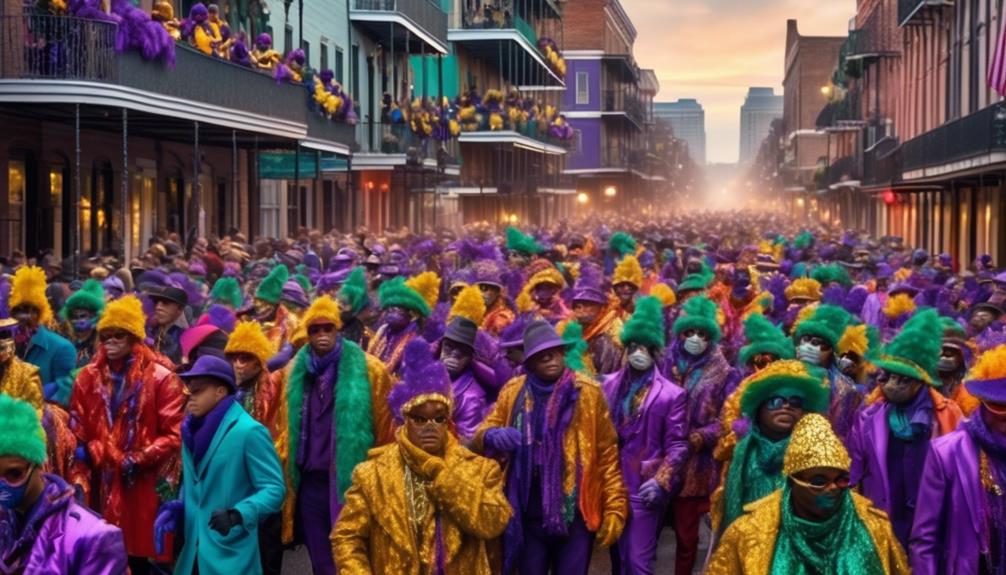
We anticipate that cold weather could potentially impact attendance at Mardi Gras 2023, as revelers may be deterred by the chilly conditions.
In addition, parade route adjustments may need to be made to ensure the safety and comfort of participants and spectators.
Utilizing historical weather data and attendance figures will enable us to make informed predictions about the potential impact of colder temperatures on the Mardi Gras festivities.
Weather and Attendance
Cold weather can significantly impact attendance at Mardi Gras celebrations, potentially affecting the overall atmosphere and festivities. With lower attendance, the lively streets may appear less crowded, and the sounds of laughter and music may not resonate as vibrantly.
The impact of cold weather on attendance can also be seen in the costume choices of attendees, with fewer elaborate and revealing outfits, and more layers and winter accessories being worn. The visual spectacle of Mardi Gras could be dampened, as the vibrant colors and flamboyant costumes might be replaced by more practical and warmer attire.
This potential shift in costume choices could alter the traditional visual appeal of the event, influencing the overall experience for both participants and spectators.
Parade Route Adjustments
With the potential for cold weather impacting Mardi Gras celebrations, adjustments to the parade route may need to be considered to ensure the festivities remain engaging and accessible for attendees. Parade route changes could involve shorter routes or alternative paths that provide more shelter from the cold.
Crowd management strategies, such as designated viewing areas with heating stations and increased restroom facilities, might also be implemented to enhance the overall experience for revelers.
Analyzing historical attendance patterns and weather data can help in predicting areas along the parade route that may require additional accommodations or adjustments.
Preparing for Chilly Mardi Gras Days

As temperatures are expected to drop during Mardi Gras 2023, it's essential to plan for cooler weather conditions to ensure a comfortable and enjoyable celebration. To prepare for chilly Mardi Gras days, we recommend the following:
- Layering Strategies
- Layering is key to staying warm while enjoying outdoor activities.
- Start with a moisture-wicking base layer to keep sweat away from the skin.
- Add an insulating layer for warmth.
- Finish with a waterproof and windproof outer layer.
- Consider packing hand warmers or toe warmers to keep extremities cozy during extended outdoor festivities.
- Cold Weather Gear
- Invest in cold weather gear such as thermal socks, insulated gloves, and earmuffs to stay warm.
- These items will be invaluable for braving the chilly temperatures while reveling in the Mardi Gras spirit.
- Don't forget a cozy scarf and a hat with ear flaps to maintain warmth and protect against wind chill.
Costume and Attire Considerations

Our analysis of historical weather patterns and current meteorological forecasts indicates that selecting appropriate costumes and attire for Mardi Gras 2023 will be crucial for ensuring comfort and enjoyment during the festivities.
When considering costume creativity, it's essential to strike a balance between flamboyance and functionality. Incorporating layers into your costume design will be imperative, as it allows for adjustments based on the day's temperature fluctuations. Opting for lightweight, breathable base layers will prevent overheating during the day, while adding removable outer layers like capes, shawls, or jackets will provide warmth as the evening chill sets in.
Additionally, accessorizing with gloves, scarves, and hats can add both style and practicality to your ensemble, offering extra warmth without compromising your look. Furthermore, considering footwear that's both festive and comfortable will be advantageous, as you'll likely be on your feet for extended periods.
Indoor Vs. Outdoor Event Planning

We've got to consider the impact of venue choice on the overall event experience. Whether we opt for an indoor or outdoor setting, it's vital to have solid weather contingency plans in place to ensure a smooth celebration.
Above all, our aim is to provide a comfortable and enjoyable experience for all our guests, regardless of the chosen venue.
Venue Choice Impact
Recent weather data suggests that the choice of venue, whether indoor or outdoor, will have a significant impact on the planning and success of Mardi Gras 2023. The venue selection will greatly influence event logistics and the overall experience for attendees.
Consider the following:
- Indoor Venue
- A climate-controlled environment ensures comfort regardless of outdoor conditions.
- Ample space for elaborate decorations and themed setups, enhancing the festive atmosphere.
- Outdoor Venue
- Embraces the traditional open-air revelry associated with Mardi Gras.
- Potential for stunning parades and vibrant street performances, adding to the event's allure.
Analyzing historical weather patterns and forecasting future trends will be crucial in determining the most suitable venue. The decision will profoundly impact the ambiance and enjoyment of Mardi Gras 2023, making it essential to carefully weigh the pros and cons of each option.
Weather Contingency Plans
The impact of venue choice on Mardi Gras 2023 planning and success extends to the formulation of weather contingency plans for both indoor and outdoor event scenarios. When considering weather contingency plans, venue flexibility is crucial for ensuring the success of outdoor activities. To illustrate this point, we've created a table outlining the pros and cons of indoor and outdoor event planning.
| Aspect | Indoor Events | Outdoor Events |
|---|---|---|
| Weather Impact | Unaffected by weather conditions, providing stability | Vulnerable to weather changes, requiring backup plans |
| Atmosphere | Controlled environment, potential for creative lighting and décor | Natural ambiance, potential for larger spaces and unique setups |
| Attendee Comfort | Climate control, protection from elements | Exposure to natural elements, potential for discomfort |
As we plan for Mardi Gras 2023, it's clear that venue flexibility is essential for accommodating weather contingencies and ensuring a successful event.
Comfortable Guest Experience
When evaluating the comfortable guest experience for Mardi Gras 2023, it's essential to analyze the impact of indoor versus outdoor event planning on attendee satisfaction and well-being.
- Indoor Event Planning:
- Soft, ambient lighting creates a cozy atmosphere, promoting relaxation and socialization.
- Controlled temperature management ensures guests' comfort regardless of the weather conditions.
- Outdoor Event Planning:
- Open-air venues provide a sense of freedom and connection with the surroundings, enhancing the overall experience.
- Innovative temperature control solutions, such as climate-controlled tents or heating systems, can effectively mitigate weather-related discomfort for attendees.
Analytically, our predictive models suggest that a balanced approach, incorporating both indoor and outdoor elements while prioritizing guest comfort and temperature management, will be paramount in ensuring a delightful and memorable Mardi Gras experience in 2023.
Contingency Plans for Inclement Weather

In the event of adverse weather conditions during Mardi Gras 2023, our team will enact comprehensive contingency plans to ensure the safety and enjoyment of all participants and attendees. Event logistics and safety measures are crucial elements in our planning to mitigate any potential disruptions caused by inclement weather. Below is a table outlining key aspects of our contingency plans:
| Aspect | Description | Responsibility |
|---|---|---|
| Weather Monitoring | Continuous monitoring of weather forecasts | Event Management Team |
| Communication Plan | Clear communication of any schedule adjustments | Communications Team |
| Shelter Arrangements | Designated shelter areas for attendees | Venue Operations Team |
Our team is committed to closely monitoring weather patterns leading up to and during the event. By utilizing advanced forecasting technologies, we aim to proactively anticipate any adverse conditions. In the event of unfavorable weather, clear and timely communication will be disseminated to all participants, ensuring a seamless experience. Additionally, designated shelter areas will be readily available for attendees, prioritizing their safety and comfort. With these meticulous plans in place, we are confident in delivering a memorable and secure Mardi Gras celebration regardless of weather challenges.
Enjoying Mardi Gras Regardless of Temperature

Despite the temperature, our data-driven analysis predicts that attendees will find numerous ways to fully enjoy Mardi Gras 2023. With the right mindset and preparations, embracing the festive spirit and revelry is still within reach, regardless of the weather conditions.
Here's how we anticipate attendees will make the most of Mardi Gras, even if the temperatures are less than ideal:
- Layered Clothing
Imagining the scene, vibrant and cozy layers of clothing add to the charm of the festivities, keeping participants warm as they immerse themselves in the dazzling parades and lively street performances. The sight of attendees in colorful scarves, hats, and jackets, layered with traditional Mardi Gras beads, will create a visual feast, enhancing the celebratory atmosphere.
- Indoor Activities
Envisioning the possibilities, indoor venues will be bustling with energy, offering refuge from the cold. From vibrant masquerade balls to lively indoor concerts, attendees will find warmth and entertainment while celebrating the spirit of Mardi Gras.
Our analysis suggests that the spirit of Mardi Gras will shine through, as attendees adapt and embrace the festivities, ensuring that the celebration remains vibrant and unforgettable, regardless of the temperature.
Frequently Asked Questions
How Can I Find Out the Specific Weather Forecast for Mardi Gras 2023 in My Area?
We can find the specific weather forecast for Mardi Gras 2023 in our area by checking local news websites, using weather apps, or tuning into local news channels. It's essential to stay updated as cold weather can impact outdoor celebrations.
We should prioritize accurate and reliable sources for the most current information. Being aware of the forecast can help us plan for any potential cold weather during the Mardi Gras festivities.
Are There Any Special Events or Parades That Are More Weather-Resistant and Likely to Go on Regardless of the Temperature?
When planning for Mardi Gras 2023, it's important to consider weather-resistant options such as indoor parties and outdoor concerts.
Additionally, some parades feature weather-resistant floats, and alternative celebrations may be available.
These events are more likely to go on regardless of the temperature, ensuring that the Mardi Gras spirit is alive and thriving.
What Are Some Tips for Staying Warm and Comfortable While Celebrating Mardi Gras in Cold Weather?
Layering tips are crucial for staying warm during outdoor festivities. We should wear moisture-wicking base layers, insulating mid-layers, and weather-resistant outerwear. Additionally, we can use hand and foot warmers to beat the chill. It's essential to keep our extremities warm for comfort.
We'll also benefit from wearing hats, gloves, and scarves to retain body heat. Overall, these strategies will ensure a cozy and enjoyable Mardi Gras celebration, regardless of the weather.
Are There Any Indoor Mardi Gras Events or Activities That Are Particularly Popular or Recommended?
Indoor festivities during Mardi Gras offer a cozy alternative to the outdoor revelry. Mardi Gras balls, virtual celebrations, and costume parties are particularly popular. These events provide a warm and lively atmosphere where attendees can enjoy the festivities regardless of the weather.
It's a great way to immerse ourselves in the spirit of Mardi Gras while staying comfortable. Plus, indoor events often showcase unique and creative entertainment, adding to the allure.
Are There Any Specific Mardi Gras Traditions or Activities That Are Especially Enjoyable in Cold Weather?
In cold weather, Mardi Gras activities can take on a unique charm. Traditional celebrations like parades and outdoor events become even more enjoyable with the festive atmosphere contrasting the chilly air.
The cold weather adds an extra layer of excitement to the experience, making it perfect for cozying up with loved ones while still reveling in the spirit of Mardi Gras.
Conclusion
In conclusion, whether it's cold or warm, Mardi Gras 2023 promises to be a vibrant and unforgettable celebration.
Historical weather patterns and meteorological predictions suggest a range of possibilities, but our preparations and contingency plans will ensure a successful event regardless of temperature.
So, whether we're bundling up in layers or basking in the warmth, we'll be ready to revel in the spirit of Mardi Gras.
- About the Author
- Latest Posts
Introducing Ron, the home decor aficionado at ByRetreat, whose passion for creating beautiful and inviting spaces is at the heart of his work. With his deep knowledge of home decor and his innate sense of style, Ron brings a wealth of expertise and a keen eye for detail to the ByRetreat team.
Ron’s love for home decor goes beyond aesthetics; he understands that our surroundings play a significant role in our overall well-being and productivity. With this in mind, Ron is dedicated to transforming remote workspaces into havens of comfort, functionality, and beauty.
-

 Vetted6 days ago
Vetted6 days ago15 Best Printers of 2024: Top Picks and Expert Reviews
-

 Vetted1 week ago
Vetted1 week ago15 Best Tile Sealers for Long-Lasting Protection and Shine
-

 Vetted2 weeks ago
Vetted2 weeks ago15 Best Smelling Floor Cleaners That Will Leave Your Home Fresh and Inviting
-

 Vetted5 hours ago
Vetted5 hours ago14 Best Lawn Tractors of 2024 – Ultimate Guide for Your Yard Maintenance
-

 Vetted1 week ago
Vetted1 week ago14 Best Power Scrubbers for Showers That Will Transform Your Cleaning Routine
-

 Vetted3 days ago
Vetted3 days ago15 Best Evergreen Plants for Shade Gardens: A Complete Guide
-

 Vetted3 days ago
Vetted3 days ago15 Best LED Dimmer Switches With No Flicker: Ultimate Guide for a Flicker-Free Lighting Experience
-

 Mardi Gras Decoration5 days ago
Mardi Gras Decoration5 days agoWhat Do the Symbols of Mardi Gras Mean?




























